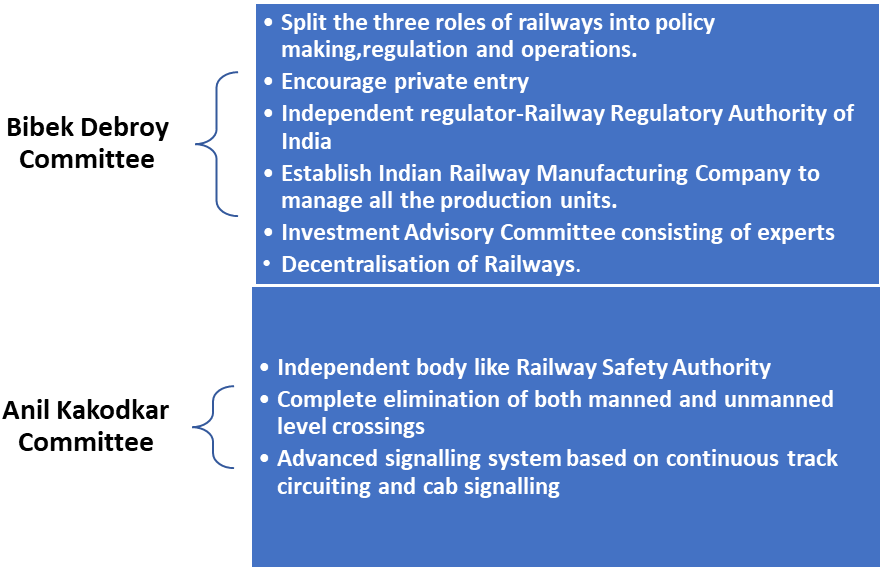Indian Railways
2023 NOV 1
Mains >
Economic Development > Indian Economy and issues > Railways
REFERENCE NEWS
Indian Railways has embarked on a substantial capital expenditure(capex) program, yet its profitability, as measured by the operating ratio, remains a challenge
RAILWAYS-SIGNIFICANCE (STATS)
- Global ranking: India has the fourth largest railway network .
- Economic impact: Rs.1 increase in railway output increases the overall economic output by Rs 3.3.(Economic Survey)
- Employment: Indian railway currently employs over 13 lakh people directly.
- Cost efficient: Indian Railways is cheaper with a rate of Rs. 2 per net tonne-km for freight and Rs. 1.6 per passenger-Km.
- Future projections: India is projected to account for 40% of the total global share of rail activity by 2050.(International Energy Agency).
ISSUES WITH RAILWAYS
I.SERVICE DELIVERY:
- Rail safety:
- Frequent rail accidents due to collisions and derailment.
- Eg: Palasa-Rayagada passenger train accident in Kantakapalli,Andhra Pradesh,2023
- Quality of service delivery:
- The CAG report highlighted concerns such as unsuitable storage conditions, overcharging and substandard food, lapses in waste management, and gaps in the complaint redressal mechanism. (Report:"Performance Audit of Catering Services in Indian Railways")
II. ADMINISTRATION:
- Monopoly: Lack of competition has led to inefficient financial and operational management.
- Centralised: The Railway Board has the powers of policy making, operations, and regulation, while zones have very limited powers with regard to raising their own revenue.
- Non-core functions: Railways’ un-remunerative peripheral activities such as running schools, and hospitals, staff housing, catering, and security causing a financial burden.
- Recruitment:
- Creation of Indian Railways Management Service (IRMS) has led to nearly 40% reduction in the cadre strength.
- Also, the recruitment made through the Civil Services exam does not measure the technical competence which is needed in Railways.
- Political involvement:
- Indian Railways has often been used as a tool for political patronage, especially during poll years.
- For example: Introduction of the "Mau-Tarighat" train service in Uttar Pradesh. Despite concerns regarding its economic viability, the train service was launched ahead of state elections.
III. FINANCIAL:
- Cross subsidy:
- The IR’s freight segment is profitable whereas the passenger segment makes huge losses.
- The CAG report August 8, 2023 states all the profit from freight traffic nullified in cross subsidising passenger services.
- Operating inefficiency:
- The Indian Railways has an operating ratio of 98.22%, which indicates its dire state.( Revised Estimate for 2022-23)
- As much as 40% of Indian Railways lines are utilised beyond its 100% capacity.(Indian Railways, Lifeline of the Nation)
- High revenue & capital expenditure:
- Railway is the only “earning” department that fully meets the salary, and (till recently) the pension obligations out of its own earnings.
- Over 80 percent of railway budget goes towards wages and salaries.
- Low revenue generation potential:
- This has led to Railways’ heavy dependence on budgetary support .
- For eg: The annual growth in freight volume and revenue of the IR in the period April-July 2023 stand at 1% and 3% respectively, while the economy grows at 7%.
IV. EXTERNAL:
- Competition from other modes:
- Timeliness better service delivery and reasonable price makes people prefer flights over trains for longer journeys.
- As more highways are getting built rapidly, the competition from roads in freight transport is increasing at an accelerating rate.
- For eg: The IR’s modal share in India’s freight business has steadily decreased to approx. 27% from upwards of 80% at the time of independence.
- Impact of emphasis on sustainable development:
- The push for renewable is bound to have an impact on India’s coal Industries.
- As around half of the freight traffic comes from carrying coal, railways are particularly vulnerable.
GOVT.SCHEMES
- High-Speed Rail: Mumbai-Ahmedabad route with Japan's support.
- Vande Bharat Trains: 400 trains planned in five years.
- Tejas Rajdhani: Modern trains with sleeper coaches.
- LHB Coaches: Emphasis on superior LHB adoption.
- 'KAVACH' System: Indigenous train protection system.
- Automatic Signaling: Implemented on dense routes.
- Bharat Gaurav Trains: Showcasing cultural sites.
- Station Redevelopment: Enhanced facilities and amenities.
|
WAY FORWARD

OTHER POINTS
- Embrace Technology:
- Implement ultrasound flaw detection, anti-collision devices, and AI automation.
- Make way for LHB (Linke Hofmann Busch) coaches instead of ICF ( Integral Coach Factory) bogies on the lines of Shinkansen of Japan. LHB coaches don’t derail or mount on each other.
- Maintenance Evolution: Transition from manual labor to tech-driven track maintenance.
- Sanitation Upgrade: Fully adopt bio-toilets to improve sanitation and rail longevity.
- Unified Vision: Integrate 'Make in India', 'Digital India', and 'Swachh Bharat' initiatives.
- Infrastructure Boost: Focus on decongestion and new track laying.
- Insurance Promotion: Amplify awareness and adoption of the rail insurance program.
PRACTICE QUESTION
Q: Indian Railways is a strategic resource for the nation and provides a vital public good’. In the light of this statement assess the merits and demerits of privatizing passenger train services in India?(15M)
